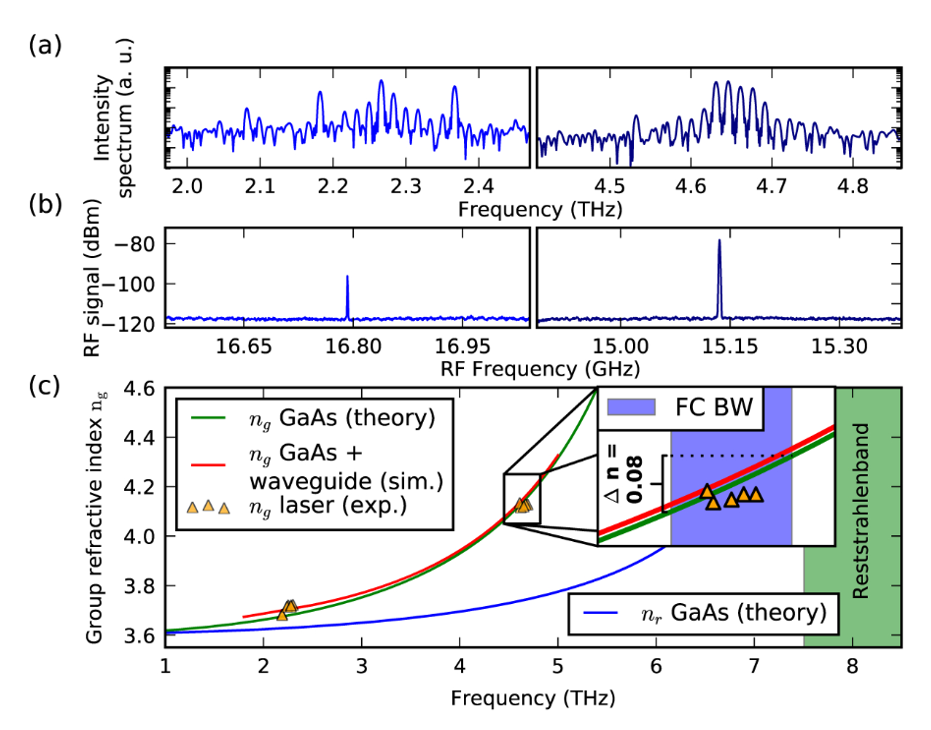Frequency Combs
In addition to mid-IR combs, QCLs can also be used to generate combs at THz frequencies, as the main driving mechanism is still four-wave mixing.
Our group has shown that it is possible to achieve octave-spanning lasers at THz frequencies using QCLs [1]. This very wide frequency coverage is possible due to the gain engineering capability of QCLs coupled to the broadband nature of the double-metal THz waveguides [1,2]. Potential octave-spanning THz QCL combs are then of interest of achieve a fully, self-referenced comb source.
In usual (homogeneous) QCLs, the active core embedded in the optical waveguide is composed of a repetition of units based on a single design. The homogeneous QCLs are characterized by homogeneous line-width broadening which means that the system suffers from gain narrowing due to mode-competition and that the envelope of the emitted spectrum is modulated by a Lorentzian function. Hence, in order to obtain a flat gain medium, a simple design optimization is not enough. The idea is to have a laser system that consists of many independent segments whose transition line-shapes are designed separately. The final gain spectrum of such a system is the sum of the contributing transitions. This is achieved by stacking different active-region designs into a common waveguide, obtaining a so-called heterogeneous QCL [3].
Octave-spanning emission of a THz QCL is achieved by stacking three different active regions in the same waveguide. Its emission spans from 1.64 THz to 3.35 THz when operated in CW operation at a temperature of 25 Kelvin, as shown in Fig. 3, and comb operation over a bandwidth of ~500 GHz [1]. Further developments led as well to octave spanning lasing and comb operation up to 1.1 THz [2] indicated by a single, narrow electrical beatnote.

One of the challenging factors of broadband comb operation in GaAs-based THz QCLs is the large material dispersion. Designing a QCL structure that operates as a comb at 2.3 THz and at 4.6 THz in the same waveguide allowed us to demonstrate this large GVD directly from a THz QCL, see Fig. 4. The octave-spaced modes have a different group refractive index that leads to a repetition rate difference in the mode spacing of 1.7 GHz (~10% of nominal frequency) in a 2.4 mm long device.
Despite the large material GVD, the gain induced GVD [1], the four-wave mixing [5] as well as dispersion engineering of the waveguide [6] still allows the formation of broad frequency combs in the THz and are ongoing research topics.
Further, the heterogeneous QCLs came with the drawback of relatively high threshold current density of ~250 A/cm2 to 400 A/cm2 and the relatively high losses of double-metal gold waveguides, limiting the temperature performance. Moreover, due to the subwavelength waveguide dimensions, the far-field is highly divergent. These shortcomings are addressed below.
Our group developed an active region design with a diagonal lasing transition that increases the upper state lifetime and has a strong photon-driven nature while preserving a broad gain curve [7]. By further embedding the active region in a lower loss copper-copper waveguide, adopted from our high-temperature THz QCLs [8], the overall performance of broad THz QCLs was improved [9]. Fig. 5.(a) shows that such devices maintain their output power when driven in CW without significant power reduction up to 70K, roughly 70% of the maximum power preserved at 80 K and CW operation up to 105 K. The threshold current density was reduced to ~100 A/cm2, a 20% decrease as compared to a double-metal gold device and a reduction of a factor 2.5 to 4 compared to heterogeneous THz QCLs [1,2]. The homogeneous active region still achieves broad comb emission spectra up to ~1 THz and non-comb emission up to 1.83 THz, see Fig. 5.(c), comparable to heterogeneous QCL bandwidths [7].
An additional advantage to the low current and higher performance of the homogeneous design comes with stabilization of the combs. Experimentally we observed an improved capability to injection lock the electrical beatnote to an RF synthesizer for the stabilization of the repetition frequency. An injection locking map of a free running beatnote is shown in Fig. 6. a). By increasing the RF power, we overcome the classical injection locking regime and are able to change the lasing state and therewith the emission spectra with an increased optical bandwidth, as demonstrated in Fig. 6. b).
References
[1] Rösch, M. et al., external page“Octave-spanning semiconductor laser”call_made, Nature Photon 9, 42–47 (2015);
[2] Rösch, M. et al. external page“Heterogeneous terahertz quantum cascade lasers exceeding 1.9 THz spectral bandwidth and featuring dual comb operation”call_made, Nanophotonics, 7(1), 237-242 (2018);
[3] Gmachl, C., et al. external page“Ultra-broadband semiconductor laser”call_made. Nature 415, 883–887 (2002).
[4] Forrer, A., et al., external page"Coexisting frequency combs spaced by an octave in a monolithic quantum cascade laser,"call_made Opt. Express 26, 23167-23177 (2018);
[5] Gustavo Villares and Jérôme Faist, external page“Quantum cascade laser combs: effects of modulation and dispersion,”call_made Opt. Express 23, 1651-1669 (2015);
[6] Burghoff, D., et al., external page“Terahertz laser frequency combs,”call_made Nature Photon 8, 462–467 (2014).
[7] Forrer, A., et al., external page“Photon-Driven Broadband Emission and Frequency Comb RF Injection Locking in THz Quantum Cascade Lasers ,“call_made ACS Photonics 2020, 7, 3, 784–791 (2020)
[8] Bosco L., et al., external page“Thermoelectrically cooled THz quantum cascade laser operating up to 210 K,”call_made Appl. Phys. Lett. 115, 010601 (2019);
[9] Forrer, A., et al., external page“RF Injection of THz QCL Combs at 80 K Emitting over 700 GHz Spectral Bandwidth,”call_made Photonics 2020, 7, 9 ;



